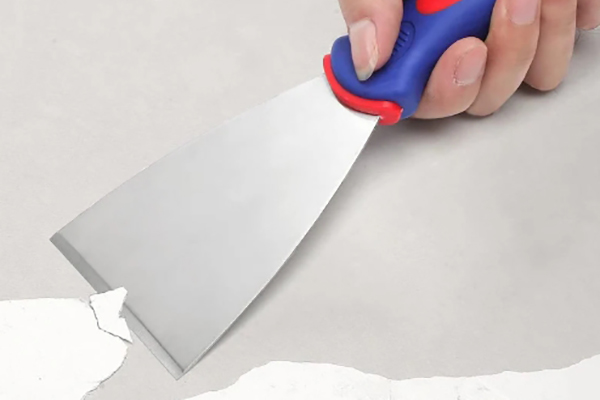A putty knife is a versatile tool commonly used to spread putty, apply drywall compounds, fill cracks, and scrape away old paint or wallpaper. Its flat, flexible blade allows for smooth, even application of materials, making it an essential tool in home improvement, construction, and painting projects. But have you ever wondered how a putty knife is made? This article delves into the process, from the raw materials to the final product.
1. Raw Materials
The manufacturing of a putty knife starts with selecting the right materials. The blade and the handle are typically made from different materials, each chosen for its specific properties.
- Blade Material: The blade is usually made from steel or stainless steel. High-carbon steel is often preferred because it offers durability, flexibility, and resistance to corrosion. For specialized or premium putty knives, stainless steel may be used, as it is rust-resistant and provides excellent durability.
- Handle Material: The handle can be made from wood, plastic, rubber, or composite materials. Wooden handles offer a traditional look and feel but may require more maintenance. Plastic or rubber handles are more common in modern designs, offering a more ergonomic grip and increased durability.
2. Design and Shaping the Blade
Once the raw materials are selected, the next step in making a putty knife is shaping the blade. This process begins with steel sheets cut to the desired size using specialized machinery.
- Cutting: Large sheets of steel are cut into smaller rectangles, which will form the basic shape of the blade. A die-cutting machine is often used to precisely cut these sheets into the dimensions needed for the putty knife.
- Forming the Blade: After cutting, the steel is pressed into the shape of a blade using a stamping machine. This machine applies pressure to the steel, shaping it into a characteristic flat, wide design. At this stage, the blade can also be customized to different widths, from narrow blades for detailed work to wide blades for spreading larger amounts of material.
- Tapering and Beveling: The blade is then tapered to provide the necessary flexibility. Tapering refers to making the blade thinner toward the edge, allowing for smoother application of materials. For tasks that require more precise scraping, the blade might be beveled, creating a sharp edge that can remove materials cleanly. Some putty knives have a slight curve or rounded edges for specific applications.
3. Heat Treatment
After shaping, the blade undergoes a process known as heat treatment to increase its durability and flexibility. Heat treatment involves heating the blade to a high temperature and then cooling it rapidly. This process strengthens the metal by altering its molecular structure, making the blade more resilient to wear and tear.
- Hardening: The steel is first heated to a very high temperature in a furnace. The exact temperature and duration depend on the type of steel used and the desired properties of the blade.
- Tempering: After heating, the blade is cooled quickly in a process called tempering. This step ensures that the blade retains its flexibility without becoming too brittle. Proper tempering is crucial for the blade’s performance, as it ensures a balance between hardness and flexibility.
4. Polishing and Finishing the Blade
Once the heat treatment is complete, the blade goes through a finishing process to smooth and polish the surface. The goal is to remove any rough edges or imperfections that may have occurred during shaping and heat treatment.
- Grinding: A grinding machine is used to smooth the edges and sharpen any bevels or tapers. This step ensures the blade is uniform and that its edges are clean and sharp.
- Polishing: After grinding, the blade is polished to give it a clean, finished appearance. Polishing may also help remove any rust or oxidation that occurs during heat treatment. Some blades are given a protective coating at this stage to prevent rusting, especially if they are made from carbon steel.
5. Attaching the Handle
With the blade complete, the next step is attaching the handle. The handle serves as the grip and is designed for comfort, especially during extended use.
- Handle Design: Handles come in various designs, from basic straight handles to ergonomic shapes that offer better control and reduce fatigue. Wooden handles are often sanded and varnished, while plastic or rubber handles are molded into shape.
- Assembly: To attach the blade to the handle, the blade is usually inserted into a slot in the handle. It can be riveted, screwed, or glued into place, depending on the design and the manufacturer’s process. Some higher-end putty knives may have reinforced handles with metal caps or collars to provide extra durability.
6. Quality Control
Before the putty knife is ready for sale, it goes through a final quality control check. Inspectors examine each knife for any defects, such as uneven edges, improperly attached handles, or flaws in the blade material. The knife is tested to ensure that it meets the manufacturer’s standards for flexibility, durability, and performance.
7. Packaging and Distribution
After passing quality control, the putty knives are cleaned and packaged for distribution. Packaging may include protective sheaths for the blade or blister packs that display the knife in retail settings. Once packaged, the knives are shipped to retailers or distributors, where they are sold to customers for use in various applications.
Conclusion
The process of making a putty knife involves several carefully executed steps, from selecting the right materials to shaping, heat treating, and assembling the tool. Each step plays a crucial role in creating a putty knife that is durable, flexible, and effective for tasks like spreading and scraping. By understanding how a putty knife is made, we can better appreciate the craftsmanship and engineering that goes into creating this simple yet essential tool.
Post time: Oct-17-2024







